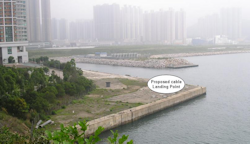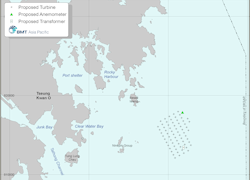
Site Selection
The site selection process is probably the single most important method for mitigating potential environmental impacts
from a wind farm. By choosing the right site and cable route it is possible to largely mitigate many potential impacts before
they arise.
1. Consultation
Consultation has been a vital part of the Project development process. Prior to the commencement of the EIA, a group of
over 80 people representing interested companies, green groups and Government attended a workshop, hosted by Civic
Exchange, introducing the project.
Since then the Project Proponent together with CLP has conducted extensive consultations with project stake holders,
including: individuals, organisations, Government Departments and many others. This has included conducting visits to
the site by boat, presentations and meetings.
The feedback from these consultations has been important during the preparation of this EIA. The list adjacent shows
some of the key Consultees.
2. Wind Farm
There are several factors that need to be considered when assessing the location of a potential offshore wind farm,
including:
Eliminating areas of potential sensitivity and considering other technical issues it was possible to consider which areas of
HK were suited for offshore wind farm development.
3. Alternative Layout
In order to define a more specific location and turbine layout within this broad area a number of criteria were subject to
further assessment. These included grid connection, visual sensitivity, marine users, local ecological considerations,
fishing resources, civil aviation restrictions, wind direction amongst other considerations.
Because wind farms allow optimisation through changing turbine locations and sizes it was possible to consider
alternative layout options to minimise potential impact and maximise the generation of clean energy.
In this case the base scenario assumes that 67 nos. of 3MW turbines shall be installed, although the EIA Study also
allows for installation of a smaller number of larger turbines – in this case, 40 nos. of 5MW turbines. These turbines may
be available for the project and would generate approximately the same power and occupy the same total sea area, but
with a smaller footprint than the 3MW layout. They might also be more cost effective in the long run.
4. Cable Routing
A similar modelling process was carried out for the cable route as was carried out for the wind farm. Namely, potential
constraints and sensitivities were identified, the best landing option identified and then the best routing option to get there
from the wind farm.
Continue to read more about the Project >>>
The site selection process is probably the single most important method for mitigating potential environmental impacts
from a wind farm. By choosing the right site and cable route it is possible to largely mitigate many potential impacts before
they arise.
1. Consultation
Consultation has been a vital part of the Project development process. Prior to the commencement of the EIA, a group of
over 80 people representing interested companies, green groups and Government attended a workshop, hosted by Civic
Exchange, introducing the project.
Since then the Project Proponent together with CLP has conducted extensive consultations with project stake holders,
including: individuals, organisations, Government Departments and many others. This has included conducting visits to
the site by boat, presentations and meetings.
The feedback from these consultations has been important during the preparation of this EIA. The list adjacent shows
some of the key Consultees.
2. Wind Farm
There are several factors that need to be considered when assessing the location of a potential offshore wind farm,
including:
- Physical Location: Mean wind speed, water depth, seabed character, sub-surface geology, coastal processes, and
seascape / landscape assessment.
- Biological Environment: Protected areas, benthic, demersal and pelagic marine life, and birds.
- Human Environment: Utility infrastructure, economic development opportunities, tourism / leisure, archaeology,
navigation, fisheries, port facilities, civil and military aviation, radar facilities (aviation and marine).
Eliminating areas of potential sensitivity and considering other technical issues it was possible to consider which areas of
HK were suited for offshore wind farm development.
3. Alternative Layout
In order to define a more specific location and turbine layout within this broad area a number of criteria were subject to
further assessment. These included grid connection, visual sensitivity, marine users, local ecological considerations,
fishing resources, civil aviation restrictions, wind direction amongst other considerations.
Because wind farms allow optimisation through changing turbine locations and sizes it was possible to consider
alternative layout options to minimise potential impact and maximise the generation of clean energy.
In this case the base scenario assumes that 67 nos. of 3MW turbines shall be installed, although the EIA Study also
allows for installation of a smaller number of larger turbines – in this case, 40 nos. of 5MW turbines. These turbines may
be available for the project and would generate approximately the same power and occupy the same total sea area, but
with a smaller footprint than the 3MW layout. They might also be more cost effective in the long run.
4. Cable Routing
A similar modelling process was carried out for the cable route as was carried out for the wind farm. Namely, potential
constraints and sensitivities were identified, the best landing option identified and then the best routing option to get there
from the wind farm.
Continue to read more about the Project >>>








